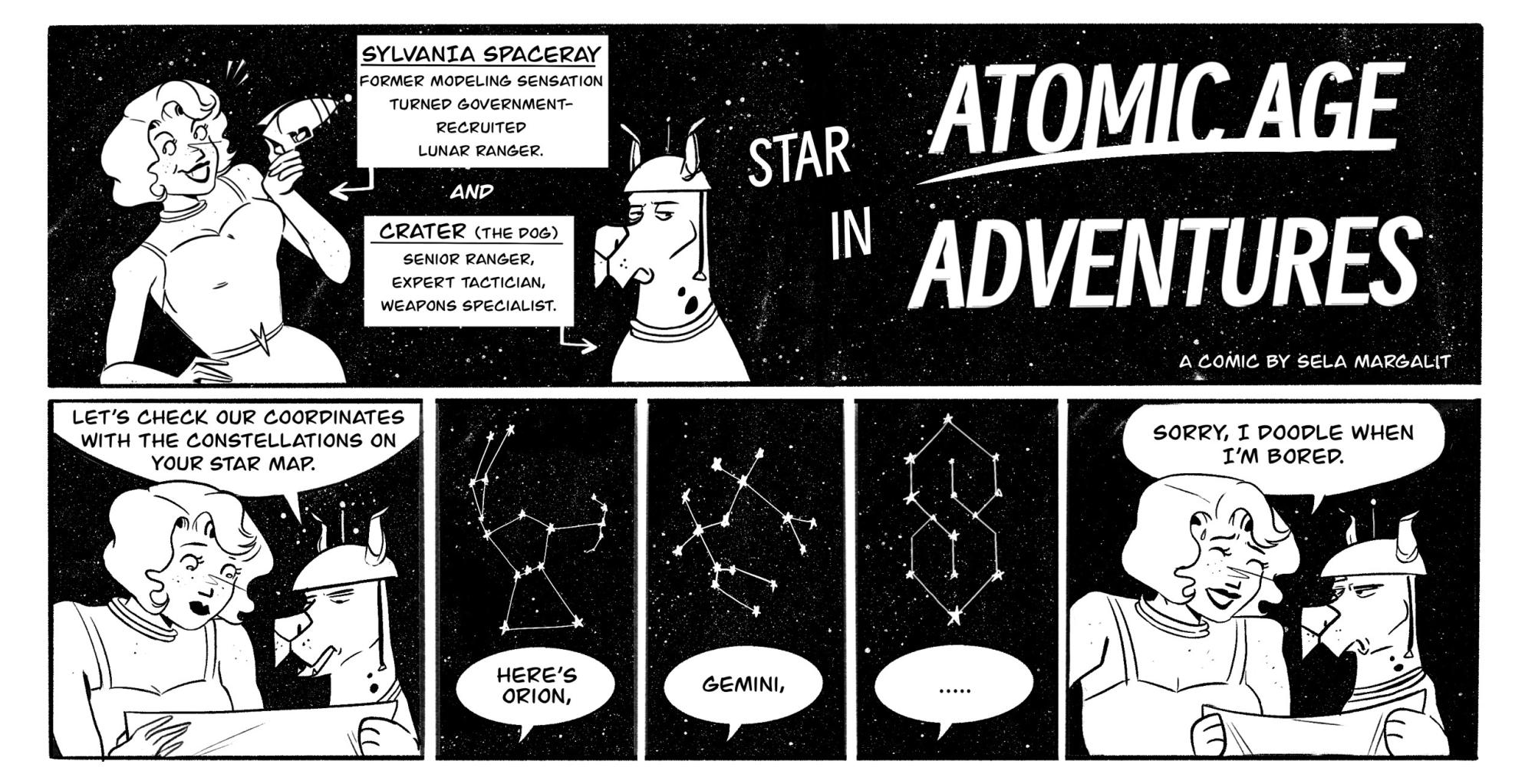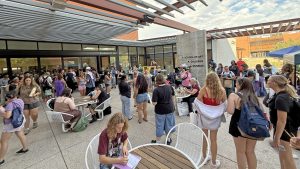
Art and medicine: Helping tomorrow’s doctors
By Michael Chesnick. December 5, 2024For future physicians Sabrina Ferrari and Thomas Brower, getting the chance to analyze paintings and sketch one with their peers helped them see the importance of observation, interpretation, communication and empathy when treating patients.
During the last four weeks of the fall 2024 semester, over 100 first-year College of Medicine students engaged with art in an innovative medical humanities workshop at the University of Arizona Museum of Art — the brainchild of School of Art graduate student Amy Hu and UAMA assistant curator and alumna Willa Ahlschwede, who’ve co-led the sessions for the last three years.
“The workshop revealed to me the significance of never overlooking even a single detail about a patient,” Ferrari said, while Brower added, “it showed me how clear and effective communication with our patients can be crucial to building trust and improving health outcomes.”

That kind of feedback brings joy to Hu, a clinical assistant professor in Psychiatry and the director of Medical Humanities for the College of Medicine, as she pursues her M.A. in Art History. She helped start the workshops to show students “there’s no single way of practicing medicine.”
“There’s been a growing trend in medical education to utilize the humanities, but it’s really been more focused on narrative medicine,” Hu said. “There hasn’t been as much focus on utilizing the cultural arts, so I thought this is something that I really would like to explore.”
Hu is a graduate of the U of A psychiatry residency program. She received her medical degree from Indiana University, and her B.A. in Art History and a B.S. in Biology from Purdue.
At a recent workshop session, Hu prepped 20 medical students in the museum’s first-floor seminar room by talking about the late French historian and philosopher Michel Foucault. He developed the concept of “the medical gaze” — the act of selecting what is relevant from a patient’s story and body and filtering out what is considered irrelevant.
“Part of the work is thinking about how we look and perceive information, and all the things that may affect that process — our biases or prior experiences,” Hu told the students. “I want to encourage you all to become a little bit more aware of your subjectivity.”

Moving to the museum’s second-floor gallery, Ahlschwede instructed the group to analyze two paintings: the surrealistic “Tenemos” (1980), an eerie, figural scene with animal imagery by Leonora Carrington; and the satirical “Beauty is Only Skin Deep” (1991), by the late Robert Colescott, a School of Art Regents professor whose garish works often referred to race and racism and pride and prejudice.
Students took a few minutes to quietly gaze at the paintings before discussing them as a group. “I appreciated having a moment of deep contemplation,” Ferrari said. “It made me realize how rare it is to replicate those moments when digesting new information from a patient. Oftentimes, there is so much background noise and other tabs open in our minds that take away from fully focusing on the person in front of us.”
In art, the meaning of a painting can be subjective, Ahlschwede told the future physicians. In medicine, she asked them, “Is there always a right answer with a patient or situation?” Most agreed every situation is different.
“Hearing my peer’s different interpretations of the two paintings was an important reminder to maintain a balanced and nuanced perspective,” Brower said. “Many of us had arrived at different conclusions when looking at the same paintings. Similarly, two physicians viewing the same patient may focus on different aspects of the disease presentation and can potentially arrive at different diagnoses.”

As Ferrari sat and scanned each inch of the paintings, she noticed each had a different color scale, cultural background, theme and medium.
“This is how each patient we will see will present. If we blink, we might miss a critical factor,” she said.
Next, students undertook a drawing exercise, in which they had to sketch a piece of artwork in the gallery — and “move outside their comfort zones,” said Ahlschwede, who received her M.A. in Art and Visual Culture Education and a certificate in Museum Studies from the U of A School of Art in 2017.
Armed with a clipboard, paper and a pencil without an eraser, students took turns with a partner being the describer and the artist — with the artist facing away from the piece. For Brower, “it was challenging both to describe the painting to my peer and to receive instructions without seeing it.”

He saw a parallel with being a physician. “At times we will be the drawer: listening to patients describe their symptoms and trying to piece that together into a collective whole,” Brower said. “At times we will be the describer: explaining a complex disease process to patients in a way they can understand.”
At first, Ferrari said her partner tried describing a painting by giving an overview of its full design and then breaking it up into smaller pieces. “The second time, her approach was to walk me through each detail of the painting, guiding the direction of my pencil. This surprisingly worked extremely well for us. It showed me … we should remain open to viewing problems from several angles.”
Ultimately, Brower said the activity “exposed some of the challenges we’ll face with our patients and the need to improve our communication.”
Communication, especially when it involves medical jargon, “can be quite tricky” for patients, Hu said. “As a doctor, you can use a word to describe something, and then you find out it may mean something different for the patient.”
In the future, Brower and Ferrari hope to draw on the workshop skills in their medical education and residencies, fellowships and careers.

“Patient education, clinical research and community outreach are all important aspects that I hope to incorporate into my practice,” Brower said, while Ferrari added: “I want to be a physician who’s not afraid to ask my colleagues or patients for insight so that I can provide the best-tailored care.”
Brower grew up in tiny Phoenixville, Pennsylvania, outside of Philadelphia, where he became interested in medicine after struggling with an immune disease that doctors helped treat and “restore my sense of self.” He did volunteer work with patients living with Alzheimer’s disease while earning his B.S. in Neuroscience and a B.A. in the History and Philosophy of Science from the University of Pittsburgh.
“One of the lessons I’ve come to appreciate is the importance of recognizing disease, injury and disability as natural parts of the human experience,” said Brower, who works in his spare time at the National Ability Center in Park City, Utah, teaching adaptive ski techniques to those with intellectual disabilities and physical or sensory impairments.
Ferrari was born in Tucson to immigrant parents from Brazil and Italy and grew up in nearby Marana, where she was “blessed to have exposure to medicine early … when my mother became a nanny for the children of a gastroenterologist and a trauma surgeon,” she said.

“My mind is still open to the many possibilities that medicine offers, as each part of the human body is so fascinating,” Ferrari said. “I’m intrigued by psychiatry and neurology, especially the intersection between the two. The great need for an increase in mental health availability for all people, especially the underserved, remains a barrier I want to address in my practice.”
Ultimately, Hu hopes medical humanities workshops will help the physicians of tomorrow break down more barriers in patient care.
As she wrapped up the session back in the museum’s seminar room, Hu told students:
“You must try to understand from the patient what they’re trying to describe, which can make about as much sense as someone trying to describe an abstract painting.
“You must really use your imagination as a doctor and put yourself in their shoes.”








